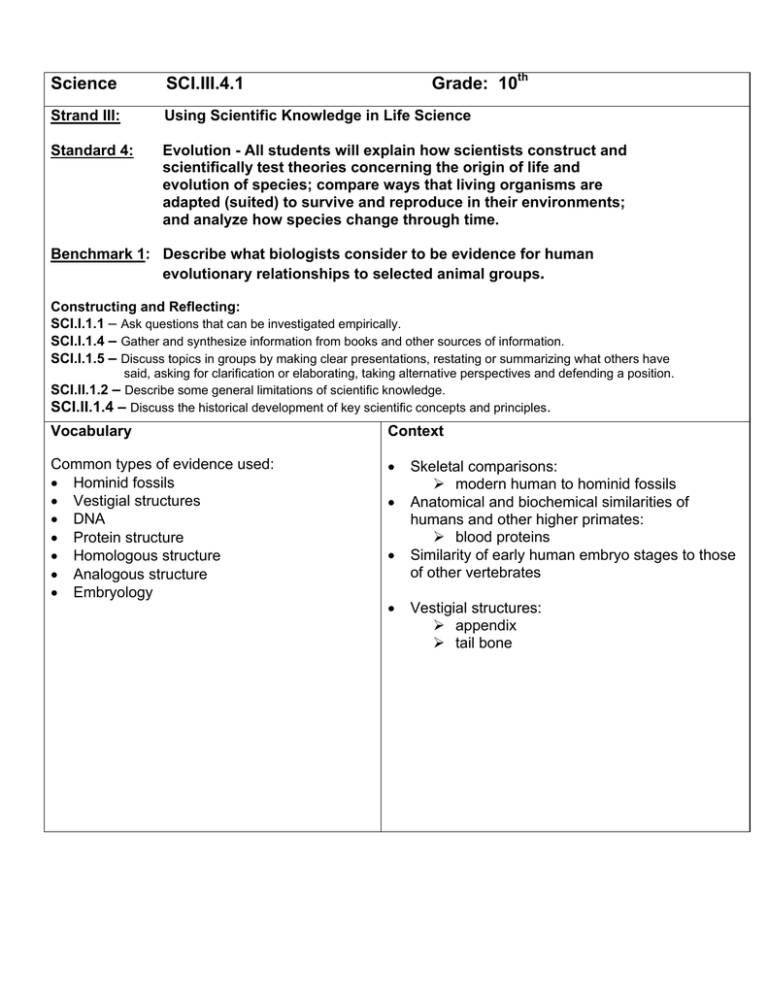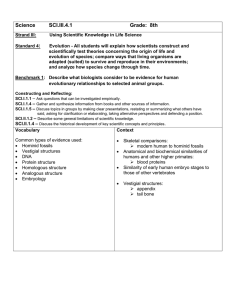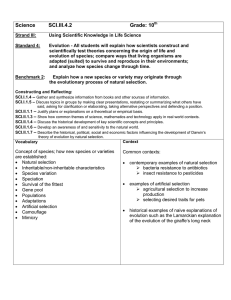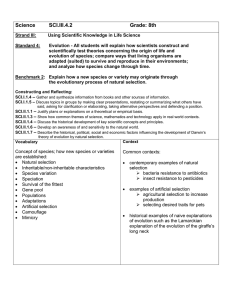Science ... Grade: 10
advertisement

Grade: 10th Science SCI.III.4.1 Strand III: Using Scientific Knowledge in Life Science Standard 4: Evolution - All students will explain how scientists construct and scientifically test theories concerning the origin of life and evolution of species; compare ways that living organisms are adapted (suited) to survive and reproduce in their environments; and analyze how species change through time. Benchmark 1: Describe what biologists consider to be evidence for human evolutionary relationships to selected animal groups. Constructing and Reflecting: SCI.I.1.1 – Ask questions that can be investigated empirically. SCI.I.1.4 – Gather and synthesize information from books and other sources of information. SCI.I.1.5 – Discuss topics in groups by making clear presentations, restating or summarizing what others have said, asking for clarification or elaborating, taking alternative perspectives and defending a position. SCI.II.1.2 – Describe some general limitations of scientific knowledge. SCI.II.1.4 – Discuss the historical development of key scientific concepts and principles. Vocabulary Context Common types of evidence used: • Hominid fossils • Vestigial structures • DNA • Protein structure • Homologous structure • Analogous structure • Embryology • • • • Skeletal comparisons: ¾ modern human to hominid fossils Anatomical and biochemical similarities of humans and other higher primates: ¾ blood proteins Similarity of early human embryo stages to those of other vertebrates Vestigial structures: ¾ appendix ¾ tail bone Knowledge and Skills Students will: • Analyze and interpret evidence supporting a progression from a common ancestry. • Resources Coloma Resources: www.dbol.glencoe.com Glenco Biology Text – CH 15 List and discuss what biologists consider to be evidence that humans evolved from more primitive forms. Other Resources: • Evolution and the Nature of Science Institute Excellent site with units and lessons dedicated to The Nature of Science, Evolution, The Origin of Life and DNA. • Brain POP Movies • • Scope Unit – Taxonomy of Evolution http://www.michigan.gov/scope/0,1607,7-15513515_13516_13519-36176--,00.html Michigan Teacher Network – 16 resources for this benchmark • • Howard Hughes Medical Institute – incredible free resources • http://www.thirteen.org/wnetschool/origlessons/ev olution/ “Scopes monkey trial” • Chicago Museum of Natural History • PBS evolution series • Local University Professors Instruction • • Compare amino acid sequences in proteins (e.g. hemoglobin) of several vertebrates, including humans. Study amino acid differences and infer evolutionary relationships among these vertebrates. Corresponds to standard I.1.4. Students will trace the evolution of a product such as cars, tennis shoes, TV or computers, including a time line and pictures of the product. Corresponds to standard I.1.4. The teacher will present the following scenario: An evolutionary biologist has been given the following information about the amino acid sequences of a protein (e.g., hemoglobin) found in the following animals. Working in pairs, students will write an essay explaining how they might compare amino acid sequences and describe the possible evolutionary relationships between two animals. (Hemoglobin level table in MI-CliMB) Assessment Optional Assessment • Construct a tree diagram that shows the evolutionary relationships among the vertebrates investigated in the instructional example. Back up your tree with supporting evidence from the chart given in the instructional example. (Evaluation rubric available in MI-CliMB) • Time line showing the progression in the theory of evolution. Corresponds to standard II.1.4. Criteria Apprent Basic Meets Exceeds Accuracy of evolutionary tree diagram Draws and labels an evolutionary tree with more than two inaccuracies. Draws and labels an evolutionary tree with one or two inaccuracies. Draws and labels a complete and accurate evolutionary tree. Draws and labels a complete evolutionary tree with exceptional quality. Explanation of evidence Provides inaccurate evidence for three or more branches based on chart. Provides inaccurate evidence for two branches based on chart. Provides accurate evidence for all branches based on chart. Provides accurate evidence for all branches with explanations. Teacher Notes: Focus Question: How do biologists evaluate evidence that humans evolved from more primitive forms of life? Explain how scientists construct and scientifically test theories concerning the origin of life and evolution of species. Are there patterns of similarity among organisms alive today? Are there relationships among organisms that lived in the past and organisms alive today? Where did humans come from in the history of the world? What is the evidence that might give us some clues to these questions? Many students come to the science classroom with strongly held beliefs that don't allow them to openly examine the scientific explanations to these questions. The challenge in the science classroom is to help students distinguish between a scientist's way of thinking and understanding from those practiced by some theologians, poets, or philosophers. Students need working definitions of key terms with clear examples to provide a framework for their thinking. This should help them demarcate where science begins and ends. Words such as fact, theory, hypothesis, and law are terms students encounter in casual conversation in everyday life. In science these terms have a very specific meaning. A fact is an observation that has been repeatedly confirmed but facts can change. It was a scientific fact for many years that human cells had 24 pairs of chromosomes. Improved techniques of microscopy revealed that they actually have 23 pairs. People commonly use the word theory to mean a "guess" or "hunch". "My theory is..." in common usage would be better stated as "My hypothesis is....". In science, a hypothesis is a testable statement about the natural world. A theory, in science, is a well-substantiated explanation of some aspect of the natural world. It is a powerful idea that represents our best explanation at this time. The abundance of supporting evidence makes the subsequent abandonment of a theory unlikely. Theories can be continually refined and even replaced with an alternative theory in light of new and compelling evidence. Finally, laws are generalizations that describe phenomena whereas theories explain phenomena. The laws of thermodynamics describe what will happen under certain circumstances; thermodynamic theories explain why these events occur. A clear understanding of these terms should provide students the structure needed to begin the study of evolution. It is important for students to be able to distinguish between evolution and the proposed mechanism, which accounts for its occurrence. Evolution is the historical change in life forms that is well substantiated and is generally accepted as fact by scientists. Students should explore the similarities of vertebrate's limb structures such as the forelimb of a chicken or bat, human, whale, cat, and lizard. They may also study similarities in the early development of vertebrate embryos. Students need an opportunity to observe, from the fossil record, kinds of organisms that once lived on earth but now are extinct such as the Petoskey stone's, Hexagonaria percarinata, trilobites, or crinoids. They can examine the apparent relatedness of fossils to one another and to organisms living today. This will begin to lay the groundwork for evidence of common ancestry. Teacher Notes: (cont.) Students are naturally drawn to questions of their own ancestry. Students can perform a simple comparison for similarities and differences when given pictures or models of a gorilla, a modern human, and a hominid fossil skull. Patterns will emerge as students discover intermediate traits and forms. Further study of the relationships of humans to other selected animal groups can be done by looking at DNA and blood protein similarities. Vestigial structures such as the appendix, tailbone, wisdom teeth, and ear muscles also give evidence to common ancestry with selected animal groups. Patterns and evidence of change, as well as recognizing the diversity and apparent relatedness of species, needs to be firmly established before delving into possible mechanisms for evolution. To better understand natural selection students can survey the examples of artificial selection occurring today with common pets like cats and dogs, or numerous agricultural products.










